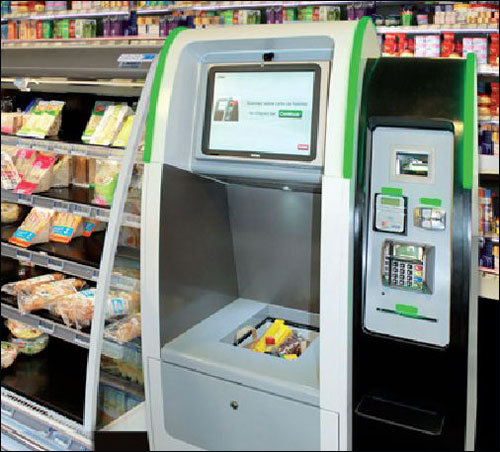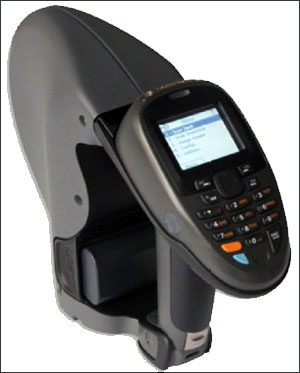Nestlé Nespresso, a manufacturer and marketer of brewing machines and ground coffee, is one of several companies testing an RFID-based kiosk enabling it to simplify the purchase process for its customers by means of the Expedited Self Payment (ESP) kiosk supplied by IER, a French manufacturer of self-service terminals and kiosks. Nespresso is currently trying out the system at its boutique in Munich, Germany. To make a purchase, shoppers can place a basket filled with the goods they wish to buy into a recessed area within the kiosk. A built-in EPC Gen 2 ultrahigh-frequency (UHF) RFID reader then captures the ID number of each item’s RFID label attached to the goods being purchased.
The solution, according to Tim Newsom, IER’s director of RFID and retail, is being targeted at smaller specialty shops offering high-value goods. By enabling consumers to transact their own purchases, the kiosk frees up a store’s staff to focus on advising customers regarding potential purchases. The system also enables a store to update its inventory data automatically as sales are made. IER produces its own RFID reader, EPC Gen 2 passive UHF labels and the software to manage the collected data. The company also provides consulting and maintenance services, and can supply its IER 680 handheld UHF RFID readers and anti-theft gates (reader portals located at doorways), if requested.
The retailer first applies RFID labels to goods, and then links each tag’s ID number with the item’s stock-keeping unit (SKU) and manufacture date, or other details. Employees can utilize an IER 680 handheld to conduct inventory checks on the sales floor, or in the back room. When making a purchase, a shopper places the goods he or she wishes to buy—which could be in a shopping bag or basket—into the kiosk’s recessed area. IER’s software generates a “shopping list” indicating which items are being purchased, along with their prices, and the kiosk’s color touchscreen displays that information for the shopper to review. That list can also provide other product information, such as an item’s expiration date and the location where it was manufactured (or, in the case of produce, harvested). Consumers have the option of scanning a loyalty card (if the retailer provides that service), and then paying either via a mag-stripe credit card, or by means of a Near Field Communication (NFC) credit card or phone, thanks to the kiosk’s built-in NFC RFID reader.
Once the purchase is complete, the kiosk prints a receipt and transmits the sales data to IER’s back-end software, residing on a cloud-based server, which updates the store’s inventory records. The shopper can then pass through the anti-theft gate linked to the kiosk. The gate’s reader interrogates the tags of all the items that the shopper is carrying, and forwards that information to the back-end software, which verifies that all products have been paid, triggering an alarm if any have not.
The ESP kiosk can also provide advertising on a second screen mounted on the back of the kiosk. This screen, which shoppers could view while passing the kiosk’s back side (for example, upon entering the store), can display videos and other advertising media about store items currently on sale.
The typical read time for all goods in a basket is approximately one second, Newsom says, compared with several minutes for a self-checkout system requiring shoppers to scan each product’s bar code. A retailer can use the RFID tag for returns, he notes, in the event that a shopper brings a purchased item back to the store. In this case, store management can read the tag and automatically locate the item in the software.
The kiosk is intended to boost sales for retailers, since sales transactions will be faster than if the store were to use manned sales counters. The readers at the doors, Newsom says, will reduce shrinkage and catch any mistakes that could be made at the point of sale. In addition, he adds, the system frees up workers’ time so that they can spend it helping customers.
The company released its IER 960 ESP kiosk during the fourth quarter of 2012, and Nespresso was the first retailer to install the system, late last year. Since then, several other specialty retailers have installed the kiosk as well. Typically, these stores have a small number of items (between 7,000 and 15,000). Potential customers, Newsom indicates, consist of small retailers, such as cell phone shops, liquor stores and clothing boutiques. In addition to marketing the technology in Europe, IER intends to expand sales to North America, and then to the rest of the world. Earlier this year, the company was among the nine technology providers nominated for RFID Journal‘s Best in Show Award, for its IER 960 kiosk and related ESP technology (see Finalists Unveiled for Seventh Annual RFID Journal Awards).




